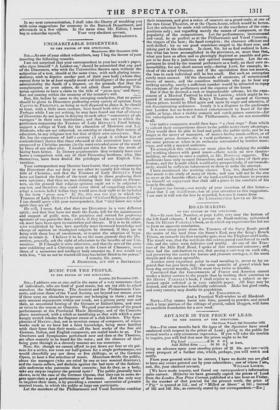ROAD-MAKING.
TO THE EDITOR OF THE SPECTATOR.
SIH—In your last Number, at page 1,298, very near the bottom of the left hand column, I find a passage on Road-making, epitomized from Sir HENRY PARNELL'S book, as to which my experience has led me to form an opposite conclusion.
It is now many years since the Trustees of time Surry Roads paved the centre of the road from the Stone's End, near the King's Bench Prison, on towards the first turnpike-gate, near the Elephant and Castle. Theresult was that the wet from this centre-paved road flowed to each side, and the sides were defective and muddy. As one of the Trus- tees of the Mile End Road, I spoke of this continual nuisance ' • and have had the satisfaction to see, that paving a cart-way on eachside, and preserving the centre for horses and pleasure-carriages, is the most durable and the most agreeable. Another most important point in road -mending is, never to lay on gravel that has just been dug : the same quantity of gravel which has been dug several months, will he more than twice :Ls durable.
Convinced that the Governments of France and America cannot render a better service to the people than by inviting their attention to Sir HENRY PARNELL'S book, I shall rejoice to see a subject so im- portant again referred o in your valuable paper. All bogs may be drained, and all marshes beneficially cultivated. Make but good roads, and every country may double its population. AN ENGLISHMAN,
And a Practical Well-wisher to all Mankind.
NOTE—Clay stones burnt into lime, ground to powder, and mixed with a large portion of the siftings of gravel, called Roggen, will form an excellent foundation for a new road.
















 Previous page
Previous page